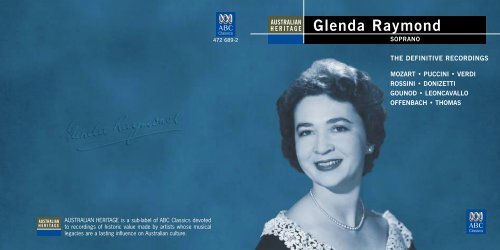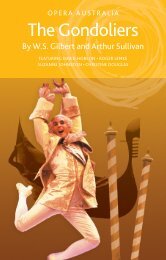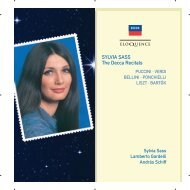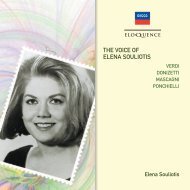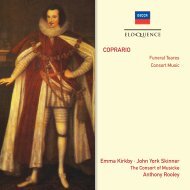Glenda Raymond - Buywell
Glenda Raymond - Buywell
Glenda Raymond - Buywell
Create successful ePaper yourself
Turn your PDF publications into a flip-book with our unique Google optimized e-Paper software.
AUSTRALIAN HERITAGE is a sub-label of ABC Classics devoted<br />
to recordings of historic value made by artists whose musical<br />
legacies are a lasting influence on Australian culture.<br />
472 689-2<br />
AUSTRALIAN<br />
HERITAGE<br />
<strong>Glenda</strong> <strong>Raymond</strong><br />
SOPRANO<br />
THE DEFINITIVE RECORDINGS<br />
MOZART • PUCCINI • VERDI<br />
ROSSINI • DONIZETTI<br />
GOUNOD • LEONCAVALLO<br />
OFFENBACH • THOMAS
<strong>Glenda</strong> <strong>Raymond</strong> soprano 1922-2003<br />
GIOACHINO ROSSINI 1792-1868<br />
The Barber of Seville (Il barbiere di Siviglia)<br />
1 Cavatina: Una voce poco fa<br />
(There’s a voice within my heart) (Act I) 4’12<br />
2 Duet: Can it be? (Dunque io son) (Act I) 5’01<br />
Geoffrey Chard baritone<br />
3<br />
JACQUES OFFENBACH 1819-1880<br />
The Tales of Hoffmann (Les Contes d’Hoffmann)<br />
Olympia’s Aria: Ev’ry grove with songbirds laden<br />
(Les oiseaux dans la charmille) (Act I)<br />
Westminster Singers<br />
6’05<br />
4 Barcarolle: Lovely night, O night of love<br />
(Belle nuit, ô nuit d’amour) (Act II)<br />
John Lanigan tenor<br />
2’55<br />
5 Antonia’s Aria: Thou art flown dove that I cherish<br />
(Elle a fui, la tourterelle) (Act III)<br />
GIACOMO PUCCINI 1858-1924<br />
La bohème<br />
2’08<br />
6 Lovely maiden by moonlight (O soave fanciulla) (Act I)<br />
John Lanigan tenor<br />
3’25<br />
7<br />
AMBROISE THOMAS 1811-1896<br />
Hamlet<br />
Pâle et blonde (Pale and fair) (Act IV)<br />
GIUSEPPE VERDI 1813-1901<br />
Rigoletto<br />
4’14<br />
8 While at the altar praying (Tutte le feste) (Act II) 2’08<br />
4<br />
CHARLES GOUNOD 1818-1893<br />
Faust<br />
9 Final Trio: Now leave her! (Alerte, alerte) (Act V) 3’10<br />
John Lanigan tenor; David Allen baritone<br />
GAETANO DONIZETTI 1797-1848<br />
The Daughter of the Regiment (La Fille du Régiment)<br />
0 Amid sounds of battle … (Au bruit de la guerre …) (Act I) 6’37<br />
David Allen baritone; Westminster Singers<br />
WOLFGANG AMADEUS MOZART 1756-1791<br />
Così fan tutte<br />
! This portrait … (Ah guarda, sorella) (Act I) 3’20<br />
Sylvia McPherson mezzo-soprano<br />
CHARLES GOUNOD<br />
Mireille<br />
@ Valse-ariette: O légère hirondelle (O airy swallow) (Act I) 3’49<br />
John Amadio solo flute<br />
Romeo and Juliet (Roméo et Juliette)<br />
£ Final duet: Where am I? (Où suis-je?) (Act V) 5’04<br />
John Lanigan tenor<br />
HEINRICH PROCH 1809-1878<br />
$ Deh, torna mio bene (Ah, return my dearest)<br />
(Air and Variations), Op. 164 5’01<br />
5
FRIEDRICH VON FLOTOW 1812-1883<br />
Martha<br />
% The Last Rose of Summer (Letzte Rose) (Act II) 2’45<br />
John Lanigan tenor<br />
^<br />
AMBROISE THOMAS<br />
Mignon<br />
I am Titania (Je suis Titania) (Act II)<br />
RUGGIERO LEONCAVALLO 1857-1919<br />
Pagliacci<br />
4’12<br />
& Nedda’s Aria: Hark! you beautiful songbirds<br />
(Stridono lassù) (Act I)<br />
ROBERT BURNS 1759-1796<br />
2’35<br />
* Comin thro’ the rye<br />
Eunice Garland piano<br />
2’20<br />
PAOLO TOSTI 1846-1916<br />
( Goodbye 4’31<br />
6<br />
Total Playing Time 73’46<br />
<strong>Glenda</strong> <strong>Raymond</strong> soprano<br />
The Australian Symphony Orchestra<br />
Hector Crawford conductor<br />
2, $, orchestra and conductor unknown<br />
<strong>Glenda</strong> <strong>Raymond</strong> 1922-2003<br />
A Stellar Talent<br />
by John Cargher<br />
In the mid-20th century Australians knew<br />
more about opera than the English.<br />
They were excessively proud of their<br />
singers. The world’s most famous prima<br />
donna, Nellie Melba, had been Australian<br />
and thereafter every soprano, good, bad or<br />
indifferent, became an instant celebrity,<br />
while many an equally good tenor or<br />
baritone happily basted in obscurity. The<br />
fault lay largely with Melba herself. One<br />
of her more admirable traits was the<br />
encouragement she gave to young Australian<br />
sopranos. As a consequence they all claimed<br />
to have been discovered by, taught by or<br />
ruined by Nellie. Whatever her failings as a<br />
person, nobody denies Melba’s genuine<br />
place as an artistic icon in the history of her<br />
native country.<br />
Few of the many sopranos who rightly<br />
or wrongly claimed an association with<br />
Melba achieved lasting fame. The few who<br />
brought further credit to Australia – Marjorie<br />
Lawrence, Florence Austral, Joan Hammond,<br />
Marie Collier, to name but four – owed little<br />
or nothing to their famous predecessor. Even<br />
less so two sopranos who provided the<br />
voices for Melba biographies: on film Patrice<br />
7<br />
Munsel and on television Roslyn Dunbar.<br />
(More recently the admirable Yvonne Kenny<br />
sang for Melba in a second television series.)<br />
The only real contender as an imitation<br />
Melba is the subject of this CD, <strong>Glenda</strong><br />
<strong>Raymond</strong>, who provided the voice for a<br />
radio biography of Melba covering no less<br />
than 52 episodes in 1946 and another 26<br />
a few years later. The series made her a<br />
household name in Australia, but her stage<br />
career was negligible through choice, not<br />
lack of talent.<br />
<strong>Raymond</strong> was discovered by a notable<br />
pioneer of Australian radio and television,<br />
Hector Crawford, who ought to be remembered<br />
also for his immense contribution to<br />
the arts. He had a remarkable record of major<br />
achievements in so many different fields,<br />
yet he was a modest man. Unsurprisingly,<br />
his later marriage to his protégée <strong>Glenda</strong><br />
<strong>Raymond</strong> was not the subject of any publicity<br />
campaign either. <strong>Raymond</strong> continued to<br />
sing after marrying Crawford, but opportunities<br />
in post-war Australia were limited.<br />
While England also suffered a musical<br />
recession after the end of the Second<br />
World War, the voice of this new Australian<br />
soprano found instant recognition in that<br />
country when she arrived there in 1948.<br />
Born in Melbourne on 26 October 1922,<br />
<strong>Glenda</strong> <strong>Raymond</strong> was brought up by her
grandmother; her parents separated when<br />
she was only two. Beyond the fact that her<br />
mother and an uncle had good voices and<br />
by all accounts sang Victorian ballads very<br />
well, there was no attempt to encourage<br />
young <strong>Glenda</strong> to take an interest in things<br />
musical or artistic. She became a teller in a<br />
bank and, like hundreds of other Australians<br />
since Europeans settled the continent,<br />
sang in church choirs in her spare time.<br />
Anyone listening to the voice represented<br />
on this CD will find it difficult to believe<br />
that this well-placed brilliant soprano voice<br />
had no basic training whatever prior to<br />
blithely accepting the task of replicating<br />
Melba’s voice in the 52 weekly radio hours<br />
of The Melba Story.<br />
Inevitably, under the guidance of Hector<br />
Crawford, <strong>Raymond</strong> began to take singing<br />
lessons, but it should be noted that she<br />
went to the soprano Pauline Bindley only<br />
after The Melba Story began. Without even<br />
the most basic musical education, <strong>Raymond</strong><br />
was taught a huge variety of operatic arias<br />
and, later, complete operas by Crawford<br />
and Bindley. All were recorded under the<br />
most primitive circumstances on 16-inch<br />
copper transcription discs which allowed<br />
no editing of any kind. Technical errors or<br />
mistakes by either singers or actors resulted<br />
in the re-recording of complete thirteen<br />
8<br />
minute segments of each individual program<br />
before it was broadcast nationwide by the<br />
commercial Melbourne radio station 3DB.<br />
The Melba Story also went to air in 17 other<br />
countries including New Zealand, Canada,<br />
South Africa, Ceylon, Malaya, Singapore,<br />
Jamaica and Trinidad!<br />
The actual recording was made in two<br />
unconnected sections of the Unitarian<br />
Church in East Melbourne. The conductor,<br />
Hector Crawford, the orchestra and the<br />
singers were in the church itself and the<br />
overseeing producer Dorothy Crawford<br />
directed the actors and sound effect<br />
technicians in the Church Hall. Both teams<br />
were coordinated by flashing red lights and<br />
what was produced in both venues went<br />
simultaneously via landline to the 3DB<br />
studios. It is almost miraculous that most of<br />
these primitive discs have survived in<br />
excellent condition and that the sound is<br />
amazingly good, as this CD proves beyond<br />
doubt. Compiling this tribute to the lost<br />
voice of <strong>Glenda</strong> <strong>Raymond</strong> was not made<br />
any easier by the fact that these huge discs<br />
bore no notation at all of their content,<br />
which had been listed carefully in a detailed<br />
index. When Crawford Productions was<br />
sold in 1988, the literally hundreds of discs<br />
were passed on to the National Sound<br />
Archives in Canberra, but all printed<br />
information (the index) was shredded<br />
beforehand!<br />
Thanks must be given to ScreenSound<br />
Australia, the successors to the Archives.<br />
Facilities for playing 16-inch transcription<br />
discs are not easy to find and the material<br />
for this CD was collected from tapes,<br />
cassettes and usually un-tracked CDs<br />
which, due to the lack of any index, are as<br />
difficult to research as the originals.<br />
In retrospect, the mind boggles that a<br />
practical businessman like Hector Crawford<br />
went ahead with such a huge undertaking<br />
featuring a 24-year-old without any<br />
performing experience or vocal training.<br />
In 1945 he and his sister Dorothy Crawford<br />
started Crawford Productions, which provided<br />
radio drama series to various radio stations<br />
and networks. He had been trained as a<br />
conductor by the coincidentally named<br />
Melba Conservatorium of Music and had<br />
worked professionally as a conductor. He<br />
was also acquainted with Melba’s family<br />
and heirs, the Armstrongs and Vesteys. It<br />
seemed the most natural thing to create a<br />
tribute to the great singer for radio and one<br />
of Melba’s own protégées, Stella Power, was<br />
an obvious choice to sing in the series on<br />
behalf of her own mentor. She had been<br />
promoted by the diva herself as ‘The Little<br />
Melba’ and, like Crawford himself, was<br />
9<br />
educated at the Melba Conservatorium.<br />
The Crawford offices were in the<br />
Broadcast Exchange’s studios in Melbourne’s<br />
Flinders Lane. Its various facilities included<br />
equipment to make recordings of voices<br />
and young <strong>Glenda</strong> <strong>Raymond</strong> went there to<br />
record a song as a present for her grandmother’s<br />
birthday in 1945. Crawford<br />
overheard her singing on an intercom. The<br />
hardworking bank teller was telephoned by<br />
him the next day and offered a contract at<br />
£4-7-6 a week to sing hymns with massed<br />
choirs and to provide the voice for the<br />
young Melba only. It is hard to determine<br />
why, or even whether, Stella Power was<br />
dropped from the project, but <strong>Raymond</strong><br />
ended up providing the singing voice for<br />
Melba from youth to retirement in all the<br />
episodes, while the noted actress Patricia<br />
Kennedy acted the diva. This highly<br />
professional radio drama series was an instant<br />
success and continued for a full year in 1946/7.<br />
An additional 26 half hour episodes were<br />
produced later, but in the meantime the<br />
name <strong>Glenda</strong> <strong>Raymond</strong> became a major<br />
attraction.<br />
The immensely popular concerts in<br />
Melbourne’s Botanic Gardens, ‘Music for<br />
the People’, were started by Hector Crawford<br />
in 1938 and eight years later were as<br />
popular as ever. <strong>Raymond</strong> became a regular
guest. The Vacuum (now Mobil) Oil<br />
Company sponsored The Melba Story, which<br />
was broadcast nationwide on Channel 9. Its<br />
success was so great that it was followed by<br />
a musically more varied series called Opera<br />
for the People. This also starred <strong>Glenda</strong><br />
<strong>Raymond</strong>. With the tenor John Lanigan,<br />
the baritone David Allen and various other<br />
singers, the repertoire quickly expanded.<br />
Crawford’s stable of singers was used in a<br />
huge number of different radio series over<br />
the years. No chronological record of these<br />
commercial broadcasts has been found and<br />
<strong>Glenda</strong> <strong>Raymond</strong> herself could not explain<br />
how she fitted so many engagements in<br />
Australia into the years 1946-1948.<br />
Hector Crawford created the famous<br />
Mobil Quest as a successful commercial<br />
venture in 1949. It seems unlikely that any<br />
other country in the world had a serious<br />
singing competition on radio solely concerned<br />
with ‘bringing to the attention of the public<br />
the best vocal talent available in the<br />
Commonwealth’, and requiring each<br />
competitor to sing an operatic aria. The<br />
second winner of the rich Mobil Quest<br />
prize (in 1950) was Joan Sutherland. The<br />
whole of Australia tuned in to the weekly<br />
heats and the final made headlines far and<br />
wide. Strangely enough, the rise in popularity<br />
of fully produced opera as a medium in the<br />
10<br />
1950s and 1960s caused a rise in prejudice<br />
against this supposed ‘elitist’ art form, and<br />
vocal competitions, which proliferate these<br />
days, are today no longer considered a<br />
universally acceptable form of simple<br />
entertainment, as was the case in the late<br />
1940s. With admittedly a smaller share of<br />
attention, young singers today get a clearer<br />
career path in Australia than in the past. In<br />
post-World War II Australia serious singing<br />
was a happenstance; fine voices abounded,<br />
but their training and judging in competitions<br />
like Mobil Quest was, to say the least,<br />
not conducive to preserving young voices.<br />
It is interesting to consider what<br />
<strong>Glenda</strong> <strong>Raymond</strong>’s career might have been<br />
if she herself had been a contestant for the<br />
‘in-house’ Mobil Quest created by her<br />
husband. Times were different then. There was<br />
no sign of the larger voices now dominating<br />
the international scene. Singers like Callas<br />
and Sutherland had not yet appeared.<br />
Amelita Galli-Curci and Toti dal Monte,<br />
however beautiful their singing, had voices<br />
too small for present day demands or<br />
fashion. Similarly, the voice of <strong>Glenda</strong><br />
<strong>Raymond</strong>, no matter how good, might be<br />
considered too small in our own time, but<br />
it was right up there with the best in the<br />
immediate post-war years and this CD<br />
should prove this once and for all.<br />
By 1948 this serious performer had a<br />
pop-star-like following in Australia. The<br />
only modern parallel to her case would be<br />
the adoration of Pavarotti, but that was a<br />
worldwide phenomenon, not restricted to<br />
Australia. Clearly <strong>Raymond</strong> was not overpaid,<br />
for her sole venture overseas was made<br />
possible only through the proceeds of an<br />
Australian concert tour in early 1948. That<br />
an Australian soprano could head a bill of<br />
unknown local singers to fill concert halls<br />
Australia-wide is an indication of the oldtime<br />
enthusiasm for serious singing created<br />
by Melba earlier in the century.<br />
Patronage of singers passed <strong>Glenda</strong><br />
<strong>Raymond</strong> by. She was a ‘commercial’ artist<br />
and, therefore, presumed to be not in need<br />
of financial support. She was much too<br />
famous to take part in competitions and<br />
prior to The Melba Story had not thought of<br />
singing as a profession. She did have plenty<br />
of admirers, however, and went overseas to<br />
start an international career with three<br />
introductions. Two were to good teachers:<br />
Lina Pagliughi in Italy and Dino Borgioli in<br />
London. There was also a letter to the<br />
British conductor Basil Cameron.<br />
When <strong>Glenda</strong> <strong>Raymond</strong> ‘stopped over’<br />
in London – on her way to Italy – she<br />
telephoned Cameron, who immediately<br />
invited her to his home and thereby started<br />
11<br />
a career in England for her almost<br />
instantaneously. The London Philharmonic<br />
Orchestra was auditioning singers for a<br />
revival of Rutland Boughton’s, at that time,<br />
immensely popular music drama, The<br />
Immortal Hour. Cameron sat down there<br />
and then, rehearsed the young Australian in<br />
the principal aria, ‘How beautiful they are’,<br />
and arranged an audition for 10am the<br />
following morning. <strong>Raymond</strong> was offered<br />
the leading role immediately, and even<br />
before the first night, the LPO signed her to<br />
a long-term contract to sing in its concerts<br />
in London (including the Albert Hall) and<br />
the provinces. The Immortal Hour, conducted<br />
by the composer himself (wearing plus<br />
fours, <strong>Raymond</strong> recalled) was staged at The<br />
People’s Palace, an enormous modern theatre,<br />
seating 3000, built in Mile End Road in the<br />
East End of London in a vain attempt to<br />
create another Sadler’s Wells. The Boughton<br />
opera completed its season of several weeks<br />
and, with <strong>Glenda</strong> <strong>Raymond</strong>, became the<br />
LPO’s opening attraction for the Llangollen<br />
International Festival in Wales in 1950.<br />
There was no shortage of work in<br />
England for <strong>Glenda</strong> <strong>Raymond</strong> in the years<br />
1948 to 1950. Apart from her LPO concert<br />
contract, she appeared with the BBC<br />
Symphony Orchestra in events which<br />
included Pelléas et Mélisande by Debussy
and Handel’s Semele, both conducted by<br />
Constant Lambert. There was also a big<br />
demand for the young Australian from the<br />
large English dance orchestras. Louis Levy,<br />
Henry Hall and Sydney Torch featured her<br />
on radio and television. As in Australia,<br />
<strong>Raymond</strong> was a commercial property,<br />
although her LPO contract ensured that she<br />
was also accepted seriously as a classical<br />
artist. In Australia she was still a pop idol,<br />
even though she sang an extensive<br />
repertoire of music for which ‘serious’<br />
organisations, including the ABC, would<br />
not consider engaging her. Hector Crawford<br />
was taking a romantic interest in his new<br />
leading lady by this stage and she was<br />
actually given six months’ leave by the LPO<br />
to enable her to return to Australia to star<br />
in a 26-week series called simply <strong>Glenda</strong> –<br />
produced by the Crawfords, of course.<br />
When she returned a second time, it<br />
was for the specific purpose of marrying<br />
Hector Crawford in November 1950.<br />
Almost immediately she was invited back to<br />
England by Sir Thomas Beecham and (with<br />
apparent glee) replied by telegram ‘Sorry,<br />
can’t come.’ Her now husband wasted no<br />
time in getting his wife back to work and<br />
had no trouble convincing commercial<br />
sponsors to jump on <strong>Glenda</strong>’s continuing<br />
bandwagon, paying for a long list of radio<br />
12<br />
series on specific subjects, each lasting 26<br />
weeks. There was the inevitable sequel to<br />
The Melba Story, The Amazing Oscar<br />
Hammerstein, The Blue Danube (the story<br />
of Johann Strauss) and much more.<br />
Many famous singers say that they are<br />
self-taught or have only casually attended<br />
various teachers. None left recordings, no<br />
matter how primitive, which can substantiate<br />
their claims. <strong>Raymond</strong> is the exception<br />
which proves the rule. There is little or no<br />
difference between the untrained voice at<br />
the start of the Melba series and the voice<br />
which shone after tuition in England by Dino<br />
Borgioli and years of practical experience.<br />
Circumstances, and possibly a lack of<br />
ambition, prevented her from having<br />
renown outside the today almost obsolete<br />
medium of live radio. Everything on this<br />
CD was recorded live, if in a studio or<br />
theatre. There were no re-takes, no editing.<br />
Faults are minimal. <strong>Raymond</strong> did not have<br />
the perfect pitch on every note which was<br />
Melba’s greatest asset, but many recordings<br />
by famous artists have made commercial<br />
discs worse than these and <strong>Raymond</strong>’s<br />
command of fioriture or coloratura is way<br />
up there with the greatest in history. It must<br />
be remembered that few arias were sung on<br />
radio in original form. Abbreviations abound<br />
and sound effects, like added applause, are<br />
inclined to intrude into the endings of<br />
tracks. They are a small price to pay for<br />
singing of remarkable beauty and agility.<br />
<strong>Glenda</strong> <strong>Raymond</strong> was a star of Australian<br />
radio, not stage or film, let alone television.<br />
Not only that, but she was a star of<br />
commercial radio, not the Australian<br />
Broadcasting Commission, as it was then,<br />
which broadcast complete operas live during<br />
<strong>Raymond</strong>’s early years. She contributed<br />
immensely to the popularity of fine singing<br />
in a continent without the European<br />
background of opera as family entertainment.<br />
In the early 1950s fully staged opera<br />
seasons had only just begun to appear as a<br />
local phenomenon in Australia. The two<br />
companies proclaimed, first by Miss Gertrude<br />
Johnson in Melbourne and, later, Mrs Clarice<br />
Lorenz in Sydney as ‘National Operas’ were<br />
floundering and the Elizabethan Theatre<br />
Trust Opera Company (now Opera Australia)<br />
did not take its first steps until 1957. The<br />
Melbourne-born <strong>Glenda</strong> <strong>Raymond</strong> missed<br />
out on the important National Theatre<br />
productions of Miss Johnson, because<br />
<strong>Glenda</strong> was a friend and pupil of Pauline<br />
Bindley. Thirty years earlier Bindley and<br />
Johnson had competed in the earliest<br />
JC Williamson seasons. Twenty years earlier<br />
they had been in direct opposition in<br />
England, singing identical roles in the<br />
13<br />
British National Opera (Johnson) and the<br />
Carl Rosa Opera Company (Bindley). <strong>Glenda</strong>,<br />
now Mrs Crawford, was persona non grata,<br />
in company with Bindley and Mrs Lorenz,<br />
as far as opera in Melbourne was concerned.<br />
When Lorenz dared to bring her National<br />
Opera of NSW to the Tivoli Theatre in<br />
Melbourne in 1953 she quite possibly<br />
produced a good case of one-upmanship by<br />
hiring <strong>Raymond</strong> to sing Rosina in her<br />
production of The Barber of Seville. It seems<br />
unlikely that no suitable soprano could be<br />
found in Sydney.<br />
Once the Trust Opera Company was<br />
formed, it was inevitable that <strong>Glenda</strong><br />
<strong>Raymond</strong> would be engaged sooner or<br />
later. For whatever reason it turned out to<br />
be later. The inevitable Barber of Seville<br />
could hardly do without <strong>Glenda</strong> in 1958<br />
and opera-goers could not have guessed<br />
that her Almaviva, Donald Smith, would<br />
one day shine in more important operas. In<br />
1960 <strong>Glenda</strong> sang Gilda in Rigoletto and<br />
the Queen of Night in The Magic Flute. In<br />
love with the small role of Marzelline in<br />
Beethoven’s Fidelio, she also managed to be<br />
accepted for a few performances of that<br />
when Sylvia Fisher returned to sing Leonore.<br />
In 1970 she sang in The Secret Marriage by<br />
Cimarosa for the amateur Victorian Opera<br />
Company and a year later Despina in Così
fan tutte in the National Theatre’s last<br />
professional opera season, as ‘The Melbourne<br />
Opera‚’ at the Princess Theatre.<br />
Finis a not so long career in opera.<br />
<strong>Glenda</strong> was nearing 40 and had two children<br />
and a most successful husband. She<br />
continued to sing frequently in Graham<br />
Kennedy’s classic In Melbourne Tonight on<br />
Channel 9 while it still had regular serious<br />
spots featuring such dancers as Kathleen<br />
Gorham and Robert Pomié and the<br />
Channel 9 Chorus, which included future<br />
opera stars Gregory Dempsey and Clifford<br />
Grant. Her private life was a full one: for<br />
some years she was on the board of Crawford<br />
Productions. Pop music and television<br />
caused a drastic decline not only in radio<br />
ratings. <strong>Glenda</strong>’s day had passed before the<br />
music industry began to find a potential<br />
audience for serious recordings by local<br />
artists. One of the most prolific and most<br />
versatile singers in the history of Australian<br />
music-making was forgotten.<br />
Worth noting:<br />
The musical content of the CD may appear<br />
haphazard. It is not. It would have been<br />
easy to stick to coloratura showpieces of<br />
great excellence. ‘Comin thro’ the rye’ and<br />
Tosti’s ‘Goodbye’ are typical of the music<br />
14<br />
sung and recorded by Melba. Three items<br />
from Offenbach’s The Tales of Hoffmann were<br />
chosen to show that as far back as 1947<br />
<strong>Glenda</strong> <strong>Raymond</strong> sang the music of Olympia,<br />
Giulietta and Antonia in sequence, admittedly<br />
on radio, but well ahead of the day when<br />
recordings began to be made with one<br />
leading lady only.<br />
Tracks 4, 7 and 12 come from the earliest<br />
of The Melba Story episodes in 1946, track<br />
2 from a complete live performance of The<br />
Barber of Seville in Melbourne in 1953. It<br />
is impossible to establish the exact dates of<br />
most of the other tracks. Some may have<br />
come into being at a later date still. Note<br />
how little the quality of the voice varies.<br />
The faintly smudged roulades and runs<br />
in the early Hamlet aria (Track 7) quickly<br />
improved after <strong>Raymond</strong>’s first lessons<br />
with Pauline Bindley. Sung only a few<br />
weeks later, the Mireille aria (Track 12)<br />
shows how remarkably well-trained the<br />
voice was even before <strong>Raymond</strong> studied<br />
with Dino Borgioli in England. The<br />
difference between 1946 and 1953 is<br />
negligible. <strong>Raymond</strong> considered beauty of<br />
voice more important than technique. Easy<br />
to say for someone born with both.<br />
Project concept, research & coordination<br />
John Cargher<br />
Executive Producers Robert Patterson, Lyle Chan<br />
Editorial and Production Manager Hilary Shrubb<br />
Compilation Producer John Cargher<br />
Mastering Garry Havrillay<br />
Cover and Booklet Design Imagecorp Pty Ltd<br />
Photographs reprinted by kind permission.<br />
Original sources provided by ScreenSound<br />
Australia, the National Screen and Sound Archive.<br />
Proudly preserving the nation’s screen and<br />
sound heritage.<br />
This compilation � 2003 Australian Broadcasting Corporation<br />
© 2003 Australian Broadcasting Corporation.<br />
Distributed in Australasia by Universal Classics & Jazz,<br />
a division of Universal Music Group, under exclusive licence.<br />
Made in Australia. All rights of the owner of copyright reserved.<br />
Any copying, renting, lending, diffusion, public performance or<br />
broadcast of this record without the authority of the copyright<br />
owner is prohibited.<br />
15


